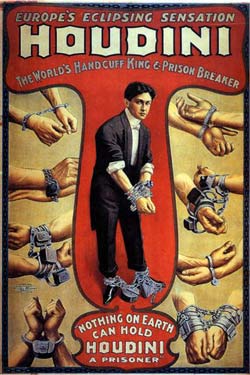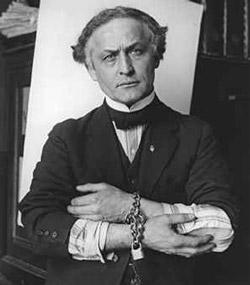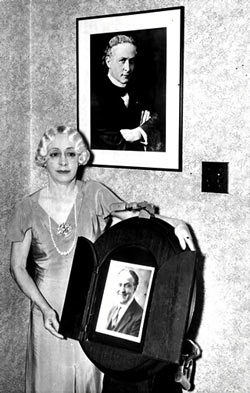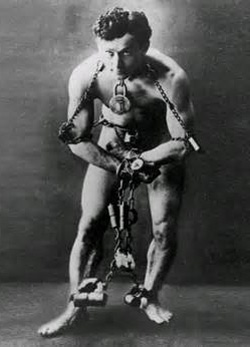 His real name was Erich Weiss, and he was born in Budapest, Austria-Hungary in 1874. Fifty-two years later, he died under the name Harry Houdini, the greatest escape artist of his age. In between, he astounded audiences around the world with his death-defying stunts. Beyond the expected handcuff escapes, he perfected the Chinese Water Torture Cell, where he was suspended upside down in a glass cabinet filled with water. And he was the bane of spiritualists and mediums, having dedicated himself to exposing their scams. But was his death in 1926 from a ruptured appendix a regrettable accident, the result of his own stubbornness, or was he killed by a stalker?
His real name was Erich Weiss, and he was born in Budapest, Austria-Hungary in 1874. Fifty-two years later, he died under the name Harry Houdini, the greatest escape artist of his age. In between, he astounded audiences around the world with his death-defying stunts. Beyond the expected handcuff escapes, he perfected the Chinese Water Torture Cell, where he was suspended upside down in a glass cabinet filled with water. And he was the bane of spiritualists and mediums, having dedicated himself to exposing their scams. But was his death in 1926 from a ruptured appendix a regrettable accident, the result of his own stubbornness, or was he killed by a stalker?
The controversy surrounding Houdini’s death isn’t something new. It began swirling almost immediately. The most common recitation of events has it that Houdini was performing at the Princess Theater in Montreal. On October 22nd, 1926, before his show, three college students from McGill University, were given the opportunity to go backstage and meet Houdini. One student, a J. Gordon Whitehead, allegedly asked Houdini if it were true that he could take a punch to the abdomen without any effect. Houdini said it was, at which time Whitehead, without warning, socked him in the stomach. (There is dispute as to whether it was a single blow or multiple ones.) Houdini had been ill, and it was thought that Whitehead’s punch ruptured his appendix.
 Houdini performed in tremendous pain that night, but ignored it and continued on with his tour in Detroit, Michigan. Suffering from the pain and a fever, he finally went to a doctor and was admitted to the hospital on October 24th with peritonitis resulting from a ruptured appendix. Houdini died, appropriately enough, on Halloween, October 31st, 1924.
Houdini performed in tremendous pain that night, but ignored it and continued on with his tour in Detroit, Michigan. Suffering from the pain and a fever, he finally went to a doctor and was admitted to the hospital on October 24th with peritonitis resulting from a ruptured appendix. Houdini died, appropriately enough, on Halloween, October 31st, 1924.
A second story simply says that Houdini was already suffering from appendicitis, an apparently recurring ailment for him, when he arrived in Montreal. There was no meeting with students, no punches thrown. Houdini simply was too stubborn to go to the doctor and paid the price for waiting too long. No punches. No murder. No mystery.
But exactly what happened in that Montreal dressing room on the night of October 22nd has been in question almost since Houdini drew his last breath. And that’s where the trouble begins. Houdini carried a $25,000 life insurance policy that included a double indemnity clause in the event of accidental death. Six weeks after Houdini’s death, the insurance investigator announced that there was no truth in the story that Houdini had been punched. In February, 1927, Houdini’s widow, Bess, challenged the finding. Her attorney collected affidavits from the three students in the dressing room, confirming that Whitehead had indeed struck Houdini. He also was able to round-up expert testimony that asserted that a sharp blow to the abdomen would, indeed, cause the appendix to rupture.
 The gambit paid off for Bess Houdini. Four months later, the original finding was reversed, Houdini’s death was ruled accidental, and she claimed the additional $25,000 payout. The one thing fishy about her efforts to get the death reclassified is that she apparently paid two of the three students $200 after the affair was settled.
The gambit paid off for Bess Houdini. Four months later, the original finding was reversed, Houdini’s death was ruled accidental, and she claimed the additional $25,000 payout. The one thing fishy about her efforts to get the death reclassified is that she apparently paid two of the three students $200 after the affair was settled.
But if there was more to Houdini’s death than would appear, the first question has to be who would have wanted the famous performer dead? The issue was most recently looked at by the investigative team on Brad Meltzer’s History Channel show Decoded. They explored a number of avenues, including the idea that Houdini’s death was due to poison, not a ruptured appendix. Few people escaped the stroke of their brush. Houdini’s crusade against spiritualists and mediums was number one on their list, and even Sherlock Holmes creator Sir Arthur Conan Doyle, himself a strong believer in spiritualism, didn’t survive untarnished. Bess Houdini came under the magnifying glass because of an alleged affair between Harry and Jack London’s widow. It was even speculated that Houdini had spied for the British during his European tours. But the team ended up split on the basic question: Was Houdini murdered?
The only possible answer at this point is: Maybe.
Dorothy Dietrich and Dick Brookz of the Houdini Museum postulate that J. Gordon Whitehead was stalking Houdini and intended to injure him. Whitehead was, admittedly, an odd duck. He was thirty years old, an advanced age for a college student in that era. A number of years later, he would die of malnutrition, possibly due to alcoholism. Their research indicates that Whitehead was a devotee of spiritualism, and a talk Houdini had done recently had angered him. They believe he intended to “teach Houdini a lesson” but that he did not intend to kill him. What makes the entire dressing room incident even more murky is that Bess Houdini’s lawyer was apparently not satisfied with the original affidavits by the other two students, and he insisted that they redo them. And don’t forget the $200 payments to the young men.
 Beyond the finding of the insurance investigator being reversed (along with the possibility that affidavits were bought and paid for), the one path that cannot be conclusively eliminated is poisoning. His relentless campaign to expose mediums and spiritualists earned him numerous death threats. After all, he was threatening their livelihood. And, yes, Sir Arthur Conan Doyle wrote him letters that could be construed as threats. Let’s not forget his well-documented affair with Jack London’s widow, Charmian, something that would not have made Bess Houdini very happy. Poisoning could cause all of the symptoms Houdini suffered. He was not autopsied, but critics point out that the magician was Jewish. However, while Jewish laws are strict on such matters, they do not completely prohibit it.
Beyond the finding of the insurance investigator being reversed (along with the possibility that affidavits were bought and paid for), the one path that cannot be conclusively eliminated is poisoning. His relentless campaign to expose mediums and spiritualists earned him numerous death threats. After all, he was threatening their livelihood. And, yes, Sir Arthur Conan Doyle wrote him letters that could be construed as threats. Let’s not forget his well-documented affair with Jack London’s widow, Charmian, something that would not have made Bess Houdini very happy. Poisoning could cause all of the symptoms Houdini suffered. He was not autopsied, but critics point out that the magician was Jewish. However, while Jewish laws are strict on such matters, they do not completely prohibit it.
A movement to exhume Houdini’s body to determine if he had been poisoned gained momentum in 2007. But the effort was ultimately quashed by members of the Houdini family. Some 87 years after the fact, it would take a forensic autopsy to lay the poisoning theory to rest. That is not to be.
When you look at the whole landscape, there are some interesting columns of smoke rising: the completely muddled tale of the dressing room, the reversal of the insurance investigator’s original finding, the payments to the two students. But all of that doesn’t add up to murder, not necessarily. A case for insurance fraud seems more likely, yet murder cannot be completely ruled out. It will remain a mystery.
Image of Beatrice via Houdini.org
When Tony Hays isn’t traveling the world, teaching students, and adopting puppies, he takes time out to write the Arthurian Mystery series from Tor/Forge.
See all posts by Tony Hays for Criminal Element.
